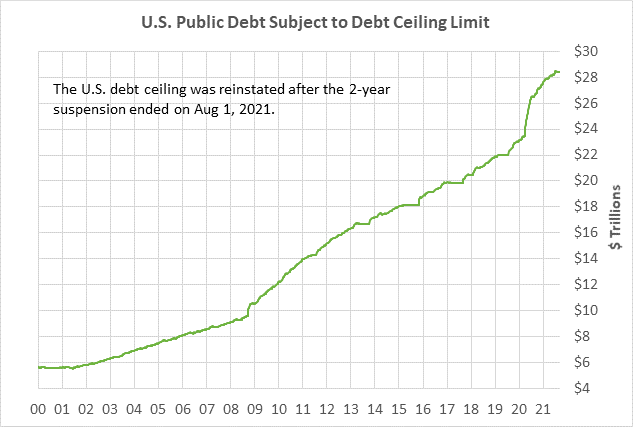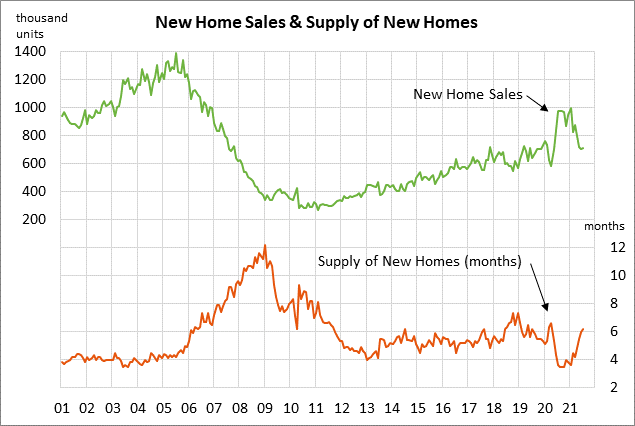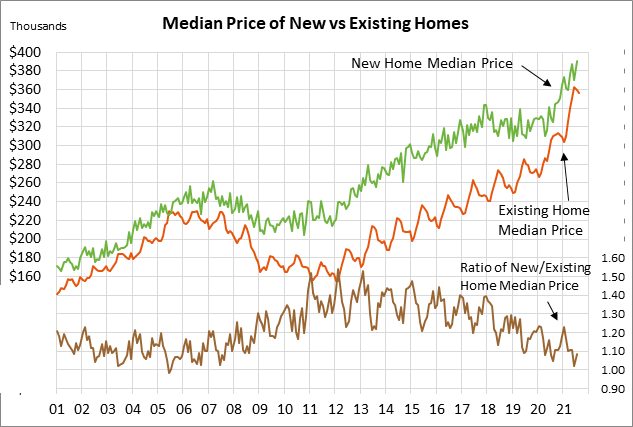- Stocks and Treasury yields rise as markets focus on economic optimism
- Pelosi says CR will pass and there will be no government shutdown but debt ceiling continues to present a major risk
- U.S. new home sales expected to edge higher
Stocks and Treasury yields rise as markets focus on economic optimism — After a day of mulling over the outcome of Wednesday’s FOMC meeting, the markets on Thursday decided to push both stocks and Treasury yields higher due to the Fed’s confidence about the U.S. economy.
The S&P 500 on Thursday closed +1.21%, and the Nasdaq 100 index closed +0.92%. Meanwhile, the 10-year T-note yield broke out to a new 2-3/4 month high and closed sharply higher by +13 bp at 1.43%.
The market’s thinking is that the FOMC’s willingness to move ahead with QE tapering at its November meeting means that the Fed isn’t particularly worried about the near-term economic obstacles. Those obstacles include the pandemic’s resurgence, weak August payroll data, a potential debt ceiling crisis, and the Evergrande debt crisis.
The FOMC meeting outcome on Wednesday made clear that the Fed plans to officially announce QE tapering at its meeting on November 1-2, barring an interim disaster. The FOMC’s post-meeting statement said, “The economy has made progress toward these goals. If progress continues broadly as expected, the Committee judges that a moderation in the pace of asset purchases may soon be warranted.”
Fed Chair Powell, in his post-meeting comments, said that the Fed is likely to wrap up its QE tapering program by mid-2022. That would be a relatively quick tapering program that would leave the door open for a rate hike by late 2022.
T-note yields Thursday also rose after the FOMC’s dot-plot forecast on Wednesday turned significantly more hawkish, increasing the odds that the Fed’s first rate hike could come by the end of 2022. The dot-plot showed that 9 of the 18 FOMC members expect at least one rate hike by the end of 2022, although the other 9 members are expecting unchanged rates.
For the end of 2023, the dot-plot’s median forecast is for the funds rate to be at 1.0%, implying three rate hikes for a total rate hike of more than 75 bp. By the end of 2024, the median forecast is for a funds rate of 1.8%, which implies a total rate hike of nearly 175 bp.


Pelosi says CR will pass and there will be no government shutdown but debt ceiling continues to present a major risk — Democrats have already relented and agreed to strip the debt ceiling hike from the continuing resolution (CR). House Speaker Pelosi yesterday said that the House and Senate will pass a CR without a debt ceiling hike by next Thursday in order to prevent a U.S. government shutdown next Friday (Oct 1). That would solve the government shutdown problem.
However, the debt ceiling continues to present major risks for the markets. If Democrats proceed with their idea of trying to force Republicans to go along with a debt ceiling suspension under regular order, Democrats will likely fail because Senate Minority Leader McConnell appears to be immovable on the matter. Also, Mr. McConnell has reportedly been actively whipping Republicans not to vote for cloture on a debt ceiling suspension.
If Democrats believe the Republicans’ claim that they will block a debt ceiling suspension with a filibuster, then Democrats have no choice but to pass a debt ceiling hike or suspension through the budget reconciliation process. The issue then becomes how long that process would take and whether Democrats can do it in time to prevent a Treasury default. Treasury Secretary Yellen has said that the Treasury’s X-date will arrive in October, while the Bipartisan Policy Center has estimated the X-date will arrive somewhere between mid-October and mid-November.
Senate Minority Leader McConnell on Thursday said that Democrats could pass a debt ceiling hike in a week through reconciliation. By contrast, House Budget Committee Chairman John Yarmuth said on Wednesday that his staff experts have concluded that, “the obstacles to amending the existing reconciliation bill are insurmountable and a new reconciliation process to raise the limit probably could not be done in time to stave off a default.” In any case, if Democrats don’t start the reconciliation process very soon to raise or suspend the debt ceiling, then the risks grow that the Treasury will default since there may not be enough time for legislative action.
Meanwhile, Speaker Pelosi and Senate Majority Leader Schumer on Thursday said that a “framework” agreement has been reached between House and Senate leaders on how to pay for the reconciliation bill. However, there is no agreement as yet on the more contentious issue of the overall spending size of the bill. Democratic moderates are pushing back on a bill as high as $3.5 trillion.
House Speaker Pelosi has said the House on Monday will vote on the $550 billion infrastructure bill. Progressive Democrats have threatened to vote against that bill since the $3.5 trillion reconciliation bill isn’t yet ready.

U.S. new home sales expected to edge higher — The consensus is for today’s Aug new home sales report to show an increase of +1.0% m/m to 715,000, adding to July’s increase of +1.0% m/m to 708,000. New home sales have fallen sharply this year from January’s 15-year of 993,000 units and are now roughly back to where they were before the pandemic. New home sales have been undercut mainly by the sharp increase in home prices, which has chased away many potential home buyers. New home prices have soared by +19% from the pre-pandemic level seen in Dec 2019.


